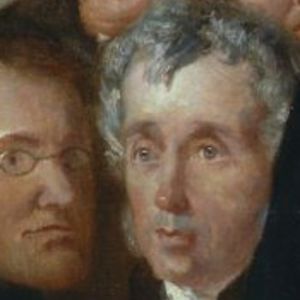William Leatham (banker) facts for kids
Quick facts for kids
William Leatham
|
|
|---|---|

François-André Isambert is to the left and Leatham is to the right in a conference crowd - detail from an 1841 painting.
|
|
| Born | 2 August 1785 |
| Died | 1842 |
| Resting place | Pontefract |
| Nationality | British |
| Education | Leeds |
| Occupation | Banker |
William Leatham (1785–1842) was an important banker from Wakefield, England. He was also a Quaker, which is a member of a Christian group known for its peaceful beliefs. Leatham was also a strong supporter of abolitionism, meaning he worked to end slavery.
Contents
Life of William Leatham
William Leatham was born in Pontefract in 1785. His father started the family banking business around 1800. William went to school at Mr. Tatum's academy in Leeds.
Becoming a Banker
By the age of 15, William began working as an apprentice in his father's bank. When he was 23, he helped the business grow. He was put in charge of the bank's branch in Wakefield. Another branch in Doncaster was managed successfully by Edward Tew.
In 1813, William Leatham married Margaret Walker. She was the daughter of a doctor from Leeds. The Leatham family was part of a powerful Quaker community in Yorkshire.
Family and Politics
William's children included William Henry Leatham and Edward Aldam Leatham. Edward was born in 1828. Both of William's sons became politicians for the Liberal party. His grandson, William Leatham Bright, also became a politician.
William Leatham's Ideas
In 1840, William Leatham wrote a series of letters. He wanted to share his ideas about how the government should manage banking. He sent these letters to Charles Wood, who was in charge of a special committee.
Thoughts on Money
Leatham believed that the government was making a mistake. He thought they were not including "Bills of Exchange" when they looked at the British economy. Bills of Exchange are like promises to pay money later. He argued that these bills made up a huge part of the economy, possibly £100 million.
He was worried because this large amount of money was only supported by a small amount of gold. Most of this gold had even been borrowed from the French government. Leatham also suggested that Britain should use silver, along with gold, to set the value of its currency.
Fighting Against Slavery
William Leatham was a strong supporter of ending slavery. In 1840, he attended a big Anti-Slavery conference. Hundreds of people from all over the world came to this meeting.
Important People at the Conference
Many important bankers were there, like George Head Head, Samuel Gurney, and George William Alexander. Famous business people like John Ellis and Tapper Cadbury also attended.
A painting from the conference shows Leatham standing near the French delegate. He is also right behind the main speaker, Thomas Clarkson. This shows how involved he was in the movement to end slavery.
Later Life and Death
In his late fifties, William Leatham retired. He moved to Leamington because of his health. He passed away there in 1842 at the age of 58.

